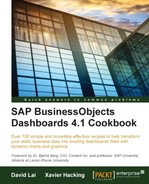A bullet chart is in fact a bar or column chart with a lot of extra options. It can serve as a replacement for gauges and meters. Besides visualizing a data point as bar and column charts do, a bullet chart is able to show a target and two or more qualitative ranges. These ranges can indicate whether a value can be considered bad, satisfactory, good, and so on.
This recipe will show you how to configure a bullet chart. SAP BusinessObjects Dashboards has two bullet chart components: horizontal and vertical. Both components have exactly the same configuration options and work in the same manner. This recipe will use the horizontal bullet chart.
Open a new file in SAP BusinessObjects Dashboards and enter the data into the spreadsheet, as shown in the following screenshot:

- Drag a Horizontal Bullet Chart component into the canvas.
- Bind the By Range field to the spreadsheet range from A4 to E7:

- Also bind the Chart field in the Titles section to spreadsheet cell A1 and bind the Subtitle field to cell A2.
- Hit the Preview button and hover on the different sections of the bars. The dashboard now shows the detailed information we just bound:

The bullet chart components can show a result value, a target, and qualitative ranges. Furthermore, each series can have its own label and sub-label. Let's have a look at exactly how these variables are configured in the preceding How to do it... section.
First, select By Series in the Data section of the properties pane for the Horizontal Bullet Chart component; then, select the Apple series. You can now see the detailed bindings SAP BusinessObjects Dashboards made for this series as shown in the following screenshot:

The Label field is bound to spreadsheet cell A5 (Apple). We did not edit the Sub-Label field so this remains empty, but you can bind it to a cell with a certain value or enter a value in this field directly. The result value, cell B5 (2200), is bound to the Performance Value field, which is represented in the chart by a small horizontal bar. Next, the target value of cell C5 (2000) is bound to the Comparative Value field. This value is visualized by a vertical dash. There are two cells that are bound as Scale Values: D5 (1800) and E5 (2400). Using two values means that the chart will show three areas: 0-1800, 1800-2400, and 2400-max. You can use as many values as you need. These areas are shown in the chart as three colored blocks in the background. If you don't use scale values, there won't be a colored block in the chart. Take a look at the following screenshot:

The bullet chart in the recipe uses the same x-axis for all three series. It is also possible to configure separate x axes as done in the following steps:
- Select the Bullet Chart component and go to the Behavior tab. Select the Scale sub-tab.
- Select Configure scale by series. Now you can edit the scaling settings for each series separately.

- Go to the Appearance tab and select the Text sub-tab.
- Here, you can select which Horizontal Axis Labels should be shown:

